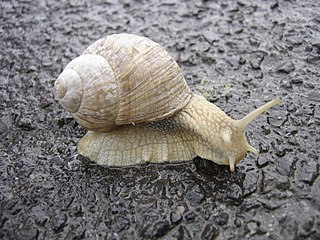
A snail is, in loose terms, a shelled gastropod. The name is most often applied to land snails, terrestrial pulmonate gastropod molluscs. However, the common name snail is also used for most of the members of the molluscan class Gastropoda that have a coiled shell that is large enough for the animal to retract completely into. When the word "snail" is used in this most general sense, it includes not just land snails but also numerous species of sea snails and freshwater snails. Gastropods that naturally lack a shell, or have only an internal shell, are mostly called slugs, and land snails that have only a very small shell are often called semi-slugs.

The gastropods, commonly known as snails and slugs, belong to a large taxonomic class of invertebrates within the phylum Mollusca called Gastropoda.
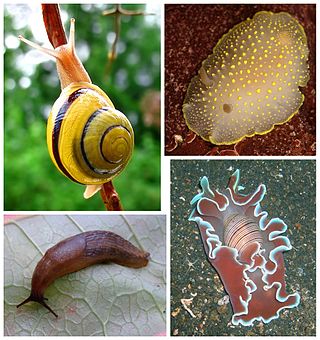
Heterobranchia, the heterobranchs, is a taxonomic clade of snails and slugs, which includes marine, aquatic and terrestrial gastropod mollusks.
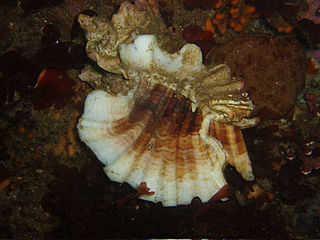
Ocenebrinae is a taxonomic subfamily of predatory sea snails, marine gastropod mollusks. This subfamily is within the large family Muricidae, which are commonly known as the murex and rock snails.

The operculum is a corneous or calcareous anatomical structure like a trapdoor that exists in many groups of sea snails and freshwater snails, and also in a few groups of land snails; the structure is found in some marine and freshwater gastropods, and in a minority of terrestrial gastropods, including the families Helicinidae, Cyclophoridae, Aciculidae, Maizaniidae, Pomatiidae, etc.

The gumboot chiton, also known as the giant western fiery chiton or giant Pacific chiton, is the largest of the chitons, growing to 36 cm (14 in) and capable of reaching a weight of more than 2 kg (4.4 lb). It is found along the shores of the northern Pacific Ocean from Central California to Alaska, across the Aleutian Islands to the Kamchatka Peninsula and south to Japan. It inhabits the lower intertidal and subtidal zones of rocky coastlines. The gumboot chiton's appearance has led some tidepoolers to refer to it, fondly, as the "wandering meatloaf". The name "gumboot chiton" seems to derive from a resemblance to part of a rubber Wellington boot or "gum rubber" boot.

Captain Frederick Wollaston Hutton was an English-New Zealand scientist who applied the theory of natural selection to explain the origins and nature of the natural history of New Zealand. An army officer in early life, he then had an academic career in geology and biology. He became one of the most able and prolific nineteenth century naturalists of New Zealand.

Sea snail is a common name for slow-moving marine gastropod molluscs, usually with visible external shells, such as whelk or abalone. They share the taxonomic class Gastropoda with slugs, which are distinguished from snails primarily by the absence of a visible shell.

Cone snails, cone shells, or cones are a large group of small- to large-sized extremely venomous predatory sea snails, marine gastropod molluscs.

The Trochidae, common name top-snails or top-shells, are a family of various sized sea snails, marine gastropod molluscs in the subclass Vetigastropoda. This family is commonly known as the top-snails because in many species the shell resembles a toy spinning top.
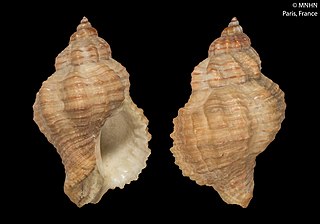
Urosalpinx is a genus of sea snails, marine gastropods in the subfamily Ocenebrinae of the murex snail family, Muricidae.

Freshwater snails are gastropod mollusks which live in fresh water. There are many different families. They are found throughout the world in various habitats, ranging from ephemeral pools to the largest lakes, and from small seeps and springs to major rivers. The great majority of freshwater gastropods have a shell, with very few exceptions. Some groups of snails that live in freshwater respire using gills, whereas other groups need to reach the surface to breathe air. In addition, some are amphibious and have both gills and a lung. Most feed on algae, but many are detritivores and some are filter feeders.

Paciocinebrina foveolata is a species of sea snail, a marine gastropod mollusk in the family Muricidae, the murex snails or rock snails.

Paciocinebrina interfossa is a species of sea snail, a marine gastropod mollusk in the family Muricidae, the murex snails or rock snails.

Paciocinebrina lurida is a species of sea snail, a marine gastropod mollusk in the family Muricidae, the murex snails or rock snails.
Paciocinebrina squamulifera is an extinct species of sea snail, a marine gastropod mollusk in the family Muricidae, the murex snails or rock snails.

In the shell of gastropod mollusks, the lip is the free margin of the peristome or aperture of the gastropod shell.

Conus is a genus of predatory sea snails, or cone snails, marine gastropod mollusks in the family Conidae. Prior to 2009, cone snail species had all traditionally been grouped into the single genus Conus. However, Conus is now more precisely defined, and there are several other accepted genera of cone snails. For a list of the currently accepted genera, see Conidae.

Terrestrial molluscs or land molluscs (mollusks) are an ecological group that includes all molluscs that live on land in contrast to freshwater and marine molluscs. They probably first occurred in the Carboniferous, arising from freshwater ones.
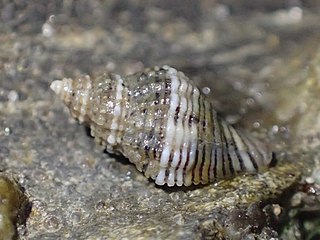
Paciocinebrina is a genus of sea snail, a marine gastropod mollusk in the family Muricidae, the murex snails or rock snails.



















